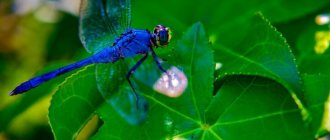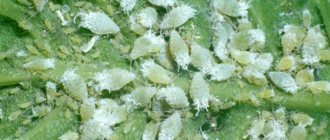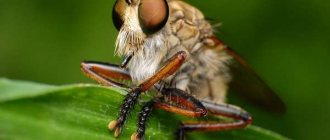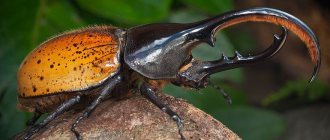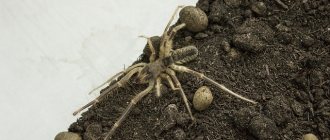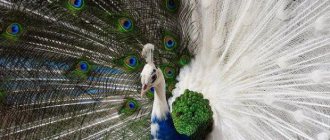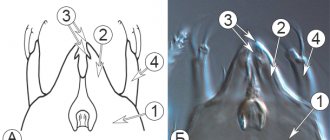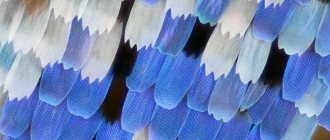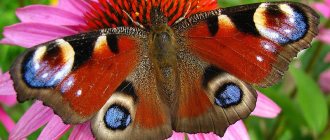Diptera, order of insects Diptera have been known in fossil form since the Late Triassic. Diptera are a progressive group with a rapid rate of evolution. They have only a front pair of wings (hence the name). The hind wings are transformed into flask-shaped organs - halteres, presumably organs of the senses of balance and direction, sometimes reduced in a few wingless forms. The head is rounded, with large compound eyes on the sides. The mouthparts are piercing-sucking or licking. The chest segments are fused together. The abdomen consists of 4-10 visible segments, the last of which are transformed in females into a telescopically retractable ovipositor, in males into a copulatory apparatus, the structure of which is a systematic (species) characteristic. Suborders; long-whiskered (or mosquitoes), short-whiskered (or flies) straight-stitched and short-whiskered round-stitched; The division is based on the structure of the antennae, head, and the characteristics of the hatching of adult individuals from the pupa shell. Diptera have over 150 modern families. About 100 thousand species, widely distributed; over 10 thousand species are known in Russia. Most adult Diptera are good flyers; They can float and hover motionless in the air.
Diptera
Diptera feed on nectar and pollen of plants, others on insects and the blood of vertebrates (gnus). Diptera have a complete transformation. Larvae live in water, soil, rotting plant debris, living plants and animals, and corpses; few, mostly carnivorous, live openly, the majority live inside the nutrient substrate, having extraintestinal digestion. The pupa of higher (round-seam) flies, as well as lionflies and gall midges, is enclosed in a lagging and hardened shell of the larva of the last (3rd) instar - the so-called. puparia, or false cocoon. A number of species of Diptera are carriers of pathogens of humans (house flies, mosquitoes, blood-sucking mosquitoes, etc.) and domestic animals (horseflies, flies, etc.). Larvae plural D. are plant pests, as well as agricultural parasites. animals and occasionally humans. Some are dipterous. useful as plant pollinators and soil formers; others, such as tachins, destroy agricultural pests.
Latin name Diptera - Diptera
The very large order of Diptera includes over 85,000 species of highly organized and specialized insects.
Diptera are insects with only a pair of membranous fore wings. Diptera are the best flyers among insects.
The hind pair of wings is reduced. Its rudiments are transformed into halteres, inside which are placed chordotonal organs, which are very important in the flight of dipterans. The wings are usually widened in the middle part, and strongly narrowed at the very base, sometimes forming a small protrusion - a wing.
Diptera are characterized by a mobile head with very large faceted eyes, a powerful chest, where the mesothorax reaches its greatest development, to which the wings are attached, and small prothorax and metathorax; sessile, sparsely stalked abdomen. The larvae are legless, with or without a head. The pupae are mobile or in a false cocoon - puparia.
Features of body structure
Some species of dipterous insects have shortened wings. There are also insects that completely lack wings. As a rule, the presence of one pair of wings is noted, while the hind wings are transformed into halteres, that is, the club-shaped organs of balance of the insect. They also help the insect perform flight maneuvers and are responsible for sensory control during takeoff. Only some parasitic forms of wingless insects lack halteres. The oral apparatus of dipteran insects is a proboscis. In total, there are three types of proboscis: piercing-sucking, muscoid (filtering) and glossinoid (boring). The abdomen consists of visible segments; in dipteran insects there are from 4 to 10. In most females, the last segments are transformed into a telescopically retractable ovipositor. The chest has three segments that are tightly fused together.
The structure of dipterous insects
Mosquitoes
Otherwise, they are also called blood-sucking mosquitoes. They belong to the group of long-moustached ones. They feed mostly on plant sap and nectar. For many, the mouthparts are also designed to pierce the skin and suck out blood. Each of these types of food is a very important source of energy for a given insect.
The body of mosquitoes is thin, up to fourteen centimeters long. They are also characterized by long limbs and narrow, almost transparent wings. Their body color is gray, yellowish or brown. There is a species of mosquito with a green or black abdomen.
The elongated abdomen is divided into ten segments. A peculiarity of the structure of mosquitoes is that the chest is slightly wider than the abdomen. They have a pair of claws at the tips of their paws. Mosquitoes have scaly wings and segmented antennae. The type of mouthparts is piercing-sucking.
A distinctive feature of the female is a long proboscis with piercing bristles. Each insect of this species has a tube-shaped lower lip. It is behind this that the oral apparatus is hidden. Also on this lip there are several jaws that allow the mosquito to cut a hole in the skin. After eruption, it plunges its proboscis into the resulting hole, through which it sucks blood. In their development, all mosquitoes go through a full life cycle from egg to adult.
The structure of the internal organs of dipteran insects
In the order Diptera, hemolymph circulates in the body, which is similar to the blood of higher type animals. Hemolymph washes the internal organs freely, since the circulatory system is open. After ablution, hemolymph is formed into vessels. Instead of a heart, dipterans have a thickened dorsal vessel, which is located in the back of the chest. Gas exchange occurs in the abdomen, as many tracheas and the aorta are located there. Also, dipteran insects are characterized by the presence of a brain.
Types of dipterous insects
Since dipterous insects are widely distributed in almost all corners of the Earth, this order belongs to one of the most widespread and wide groups of insects. The habitats of many families are still not fully known. The diversity of Diptera numbers about 100,000 species. We will consider only the most prominent representatives of this detachment.
Blood-sucking mosquitoes
Belong to the long-whiskered group. A characteristic feature is the structure of the oral cavity, since the upper and lower lips form a kind of case. This case contains two thin needles. Thanks to these needles (jaws), female mosquitoes bite people and suck blood. This is necessary to obtain nutrients to produce eggs.
In males, the jaws are underdeveloped, so they cannot bite. The olfactory organs consist mostly of receptors aimed at searching for blood, as well as various chemicals that are released in sweat. The usual diet of mosquitoes consists of nectars and plant juices. In total, there are about 3,600 species of mosquitoes in the world, but only 100 are known in Russia.
The benefits of mosquitoes include pollinating plants and cleaning water bodies. This is what the larvae do. And after death, the pupae enrich the soil with microelements. However, mosquitoes are also carriers of various diseases, although they help improve human blood circulation with their bites.
Housefly
Probably everyone has encountered this type of dipteran insect. This is a fairly common dipteran that is mainly diurnal, but can be quite active even at night. There is a distinction between housefly and small housefly. The small housefly has a gray color and a yellow spot on the lower abdomen, while the ordinary one is gray.
To produce the required amount of energy, flies need to constantly receive nutrients. Most often, they feed on liquid food or produce saliva on solid food. They prefer foods containing sugar and live in polluted places such as garbage cans and landfills. Therefore, flies carry dirt and various infections. When flies sit on food, they leave their excrement on it and regurgitate leftover food, which increases the risk of human infection with various diseases. The complete life cycle of a fly is about 8-20 days.
Tsetse fly
Tsetse flies live mostly in damp and damp habitats. All individuals of this species feed on the blood of mammals. Tsetse fly larvae are born singly and live for about a month, while the adult lifespan is about 200 days. During this time, up to nine reproductions occur. Many people know that these insects are dangerous.
They are guided by smell and bite a large moving object that emits heat. The danger is that tsetse flies infect their victims with trypanosomes. These are small single-celled animals that cause sleeping sickness, fever, rash and fever in humans. Animals can get Nagan's disease from a bite. However, such consequences are now being actively treated. Tsetse flies are beneficial for wildlife because they maintain a balance of flora and fauna and reduce soil erosion.
At the moment, only 23 species of this genus have been discovered. How to distinguish a tsetse from a housefly: the wings overlap each other, the chest has dark brown spots, the abdomen is yellow above and gray below, the antennae have hairs, the proboscis is directed forward.
Midges
Midges are small in size (2-4 millimeters) and look like very small flies. Males feed on nectar, and females can additionally drink the blood of warm-blooded animals. Many animals eat midges, and they also affect the health of the soil and pollinate plants.
Despite its small size, if you are bitten by a midge, the swelling and pain from its bite will be greater than from a mosquito bite. This is due to the fact that the midge injects a special liquid when biting, which provokes bleeding. Also, midges can carry various diseases, and their saliva can cause an allergic reaction. Now midges live almost everywhere where the air temperature can rise above 8°C. In total there are about 2000 species of these insects.
Horseflies
Horseflies belong to the short-whiskered suborder and look like large flies. Horseflies have a fleshy trunk, inside of which there are hard stylets. Horse flies have antennae that stick out forward, and their eyes are large and have spots of different colors. Only the females of these insects pose a danger, since they are the ones who can feed on blood. Males eat only plant nectars, honeydew and various liquids. Most often, horse flies can be found in various bodies of water, as they constantly drink water and lay eggs near rivers and lakes.
The bite of a horsefly is very painful, as they inject toxins and anticoagulants along with their saliva. Thus, the blood does not clot for a long time and attracts other insects. Toxins can cause redness, swelling and an allergic reaction. Horseflies can carry many dangerous diseases, so you should be careful and consult a doctor in case of severe inflammation of the bite site. These insects are most active during the warm daytime; in the tropics they can be active at night.
Currently, about 4,400 species of horseflies are known, and 176 species live in Russia.
Mosquitoes
Mosquitoes belong to the butterfly family and the long-whiskered subfamily. These insects are similar to mosquitoes and live in tropical, subtropical, and sometimes temperate climates. The body of the mosquito is transparent and covered with small hairs, and the wings have a fringe. Unlike squeaky mosquitoes, mosquitoes fly absolutely silently. They combine jumping and wing action, so their flight is also distinguishable from mosquitoes. Mosquitoes feed on various sweet liquids, rot, honeydew and mushrooms. Only females drink blood and use it to improve the quality and quantity of eggs.
A mosquito bite is very painful, and after it redness of up to 10 centimeters appears, a bump or blister. Such bites are very itchy and can appear not only individually, but also en masse. Mosquitoes carry bacterial and viral diseases and can cause severe allergic reactions. The bites are dangerous not only for people, but also for animals, causing mosquito fever and many other diseases. Currently, more than 700 species of mosquitoes are known.
Cereal (grain) flies
Cereal flies belong to the short-whiskered suborder, do not have cells at the base of the wing and are characterized by dark stripes in the thoracic region. The color can be black, gray or yellow. Most often, cereal flies are herbivorous; occasionally predatory species and saprophages are found. They acquired their names due to their harmful effect on grain crops.
Grain fly larvae eat crops and make them unusable. Farmers are actively fighting these pests, since every year grain flies cause irreparable damage to fields. Certain species of grain flies that live in the tropics can carry various diseases. Now the diversity of grain flies includes about 3,500 species, and in Russia there are 500 species.
Mokretsy
Midges belong to the suborder Long-whiskered and are small blood-sucking insects. They are distinguished by a small yellow or gray body. Due to their small size, biting midges can even fly through mosquito nets. Such insects bite very painfully and can carry dangerous diseases. Their bites can cause an allergic reaction and various complications in humans. Sometimes a bite may not bother a person, but the disease will develop inside the body. Also, biting midges can get into a person's mouth, nose, ears or eyes.
Like many other bloodsuckers, only female biting midges feed on blood for reproduction, while males consume only nectars and other liquids. Midling midges are most active early in the morning and late in the evening. They are actively distributed throughout the world and number about 4000-5000 species. Most often, biting midges live in tropical and subtropical countries; sometimes they can be found in regions with temperate and cooler climates. However, biting midges have undoubted benefits for nature. Cocoa flowers are capable of pollinating only two types of insects, and one of them is the biting midge.
The order of dipterous insects is rich and diverse. There is not a single person who has never met them. Even though many species bring some discomfort to humans and animals, without them nature would not be able to function properly. Pollination of plants and nutrition of the soil is largely due to dipteran insects.
Differences between flies by habitat
Flies choose habitats both in wild nature and in areas in close proximity to humans - such species are called synanthropic. According to the dependence and connection of flies with people, they can be village, semi-village and pasture.
Village species of flies have a direct attachment to human settlements and dwellings. Their life, the processes of reproduction and everything that flies do is in close contact with the vital processes of human life.
Such flies eat human sweat, blood and excrement, as well as human food. Their larvae develop in human waste. The most dangerous flies for humans are synanthropic flies.
Semi-settlement flies, like pasture flies, can live both in human settlements and in the wild, flying into human territory.
Diptera feeding
Most often, dipteran insects feed on pollen, nectar and liquids that are rich in microorganisms and appear on the remains of plant and animal origin that can rot. Also, this order can feed on the blood of vertebrates and be predators. Among all representatives there are species that do not feed.
Reproduction
Reproduction in dipteran insects occurs sexually. There are pedogenesis (reproduction at the larval stage) and parthenogenesis (development without fertilization, males are rare or unknown).
This unit undergoes a complete transformation. Most often, representatives of Diptera lay eggs, and some species are characterized by viviparity. Then, complete or partial development of the larva occurs in the female’s reproductive tract.
Gadflies
In fact, gadflies are still the same flies. They differ in medium size. Their larvae lead a parasitic life on mammals. There are cases when they are found in humans in the form of myiasis. Gadflies undergo a complete metamorphosis before becoming an adult. These dipterous insects spend approximately one year completing the full cycle of transformation in the subcutaneous space of the animal.
An important characteristic feature of adult individuals is the lack of nutritional requirements. The fact is that, as a larva, they accumulate the necessary amount of nutrients, the consumption of which occurs at the adult stage. Usually the adult lives from three to twenty days. During its existence, it loses up to a third of its weight.
Gadflies mate every year in the same places. After the male fertilizes the female, she immediately goes in search of an animal suitable for laying eggs. The areas that are most preferable for them are the soft abdominal wall, groin and front part of the animal’s thigh. There are gastric, subcutaneous and cavitary gadflies. The most vulnerable are horses, goats, sheep, donkeys and cattle.
